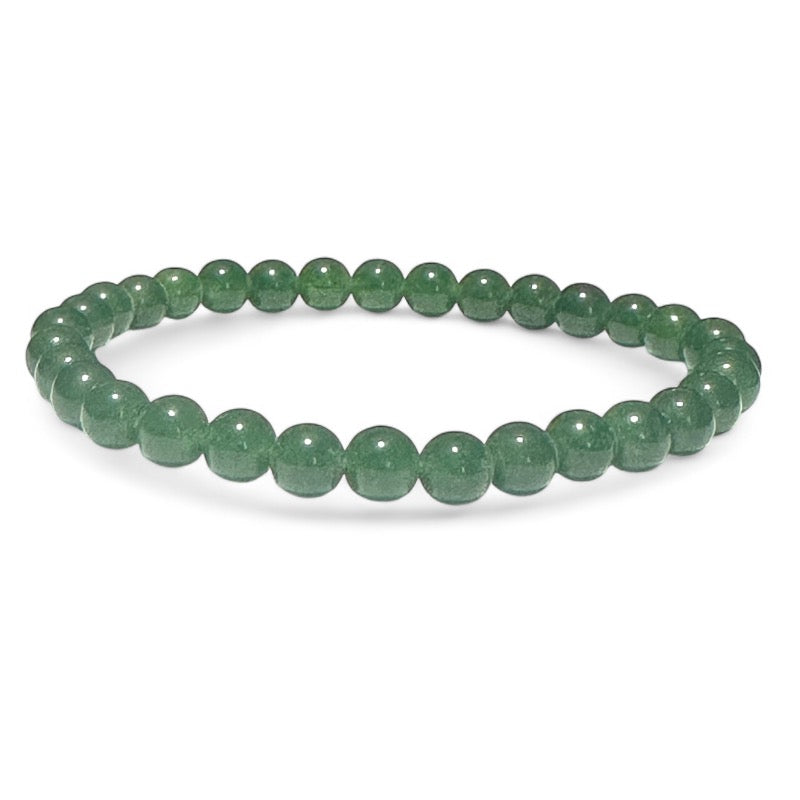Canadian AA Nephrite Jade Bracelet (5-6mm Balls)
BRA-JADV-04
- Regular price
-
24,90 € - Regular price
-
24,90 € - Sale price
-
24,90 €
Couldn't load pickup availability
Learn more
BRA-JADV-04
Origin: Canada
Grade: AA
Dimensions:
Approx 18cm - Fits all wrists from approximately 17 to 19cm
AA = very high
Very beautiful elastic bracelet made of 5-6mm Canadian nephrite jade balls.
Patterns and colors may vary from bracelet to bracelet.
Jade is a stone that is not a precious stone, but it has been worshipped, used and carved by multiple civilizations for about eight millennia.
For many years, jade was one and the same stone. However, in 1863, Alexis Damour (1808-1902), a French mineralogist, differentiated three types of minerals under the name jade and separated them. These three minerals have very distinct characteristics.
The first of these minerals is called jadeite. It belongs to the silicate family and more precisely to the pyroxene group (minerals of the inosilicate group, components of igneous and metamorphic rocks). It is the most precious, densest and rarest jade.
Its color is generally white or gray. It is rather transparent in appearance. Its hues and opacity differ depending on the inclusions it has. The most common color is more or less dark green. It varies according to its titanium, manganese, or chromium content. However, jadeite can also be pink, orange, or purple. It has the highest hardness of jades, as it is between 6 and 7 on the Mohs scale.
The second of these minerals is nephrite. Nephrite is found in greater quantities than jadeite. It is essentially composed of basic silicate of magnesium, calcium with the presence of ferric iron. Nephrite can be translucent, white or very slightly yellow, opaque, brown or gray to green and present all shades of green.
More precisely, nephrite is a rock made up of amphibole (iron and magnesium silicate) of green, black or brown color, or actinolite (ferromagnesian mineral of the silicate family). It has a hardness of 6 to 6.5 on the Mohs scale. It is less hard than jadeite, but it still allows the manufacture of tools, jewelry or ornamental objects.
The third of these minerals is kosmochlor, which is the rarest of jades. It has a composition close to jadeite and belongs to the silicate family and the pyroxene group. Depending on its impurity content and their nature, it has an emerald green hue, more or less intense. It may have traces of titanium, aluminum, iron, manganese, calcium, potassium and phosphorus.
Kosmochlor comes from the place where a meteorite fell in Toluca, Mexico. This jade comes from space. In fact, its name comes from the German "kosmische" meaning cosmic. “Chlor” comes from the Greek “khlôros” which means the color green.
It was the Portuguese who brought jade back at the end of the 15th century. In fact, they had settled in Canton in China. This mineral was then called “piedra de ijada” which translates to flank stone. This name illustrates the healing power of this stone on kidney pain, or nephritic pain.
In some Latin texts we find the name lapis nephreticus which evokes jade. The French discovered this stone in the 17th century and named it “éjade”. Later, the “e” disappeared and the mineral became jade.
Jade objects have been found dating back about 5,000 years. Jade became a sacred stone during Chinese prehistory. The deceased belonging to the elite were buried with jade. Jade represented absolute power and Chinese emperors carried a jade scepter during important ceremonies.
The Greeks possessed jade from birth to death. They also used it to soothe and heal wounds. In New Zealand, the Maori made tools, weapons and jewelry from jade.
The main jade deposits are located in Canada, Thailand, China, Russia, and the United States.
Nephrite jade is a stone of balance and energy. It balances our emotions by allowing us to free ourselves from the anxieties buried deep within us. This provides appeasement, calm and a feeling of lightness.
Indeed, it generates confidence and a certain benevolence towards oneself. It allows one to detach oneself from accumulated traumas and leaves room for the positive emotions that surround us. It helps to find inner peace. Once the mind is freed, tranquility sets in.
Nephrite jade is highly recommended for people who are weakened, too nervous and easily exhausted. It is an energy stone that restores vitality. It frees the mind from guilt, allows one to move away from the judgment of others. It gives wisdom and facilitates openness to others without preconceptions.
This mineral improves the body's endurance and spreads serenity. It is ideal for meditation and promotes introspection. Nephrite jade is said to be a stone of honesty towards oneself and others. It helps to know oneself better and to have a better understanding of oneself.
In case of breakup or loss of a loved one, wearing a nephrite jade gives the strength to overcome one's wounds and moral suffering. It stabilizes emotions and calms pain. Nephrite jade allows one to move forward after difficult trials.


Canadian AA Nephrite Jade Bracelet (5-6mm Balls)
- Regular price
-
24,90 € - Regular price
-
24,90 € - Sale price
-
24,90 €
-
100% SECURE PAYMENT
Paypal, credit card, check, transfer
-
FREE DELIVERY
from 40€ purchase
-
SATISFIED OR REFUNDED
14 days to change your mind
-
CUSTOMER SERVICE AVAILABLE
contact@laboiteacailloux.com
to receive all our offers, good deals and new products from La Boite à Cailloux


